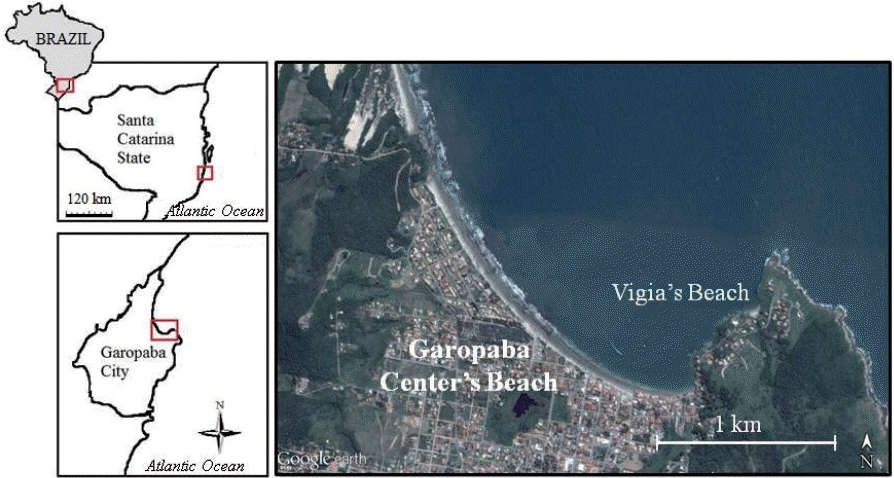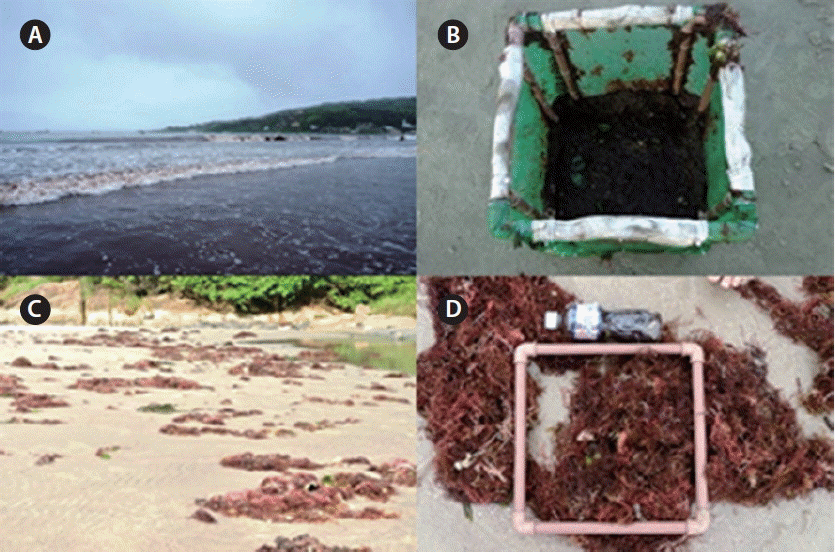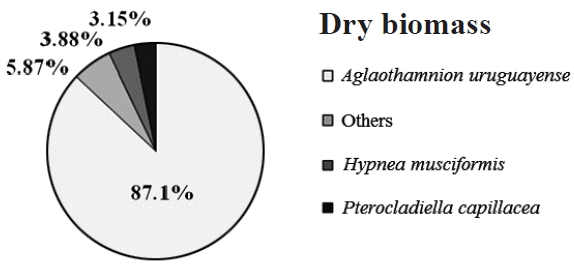INTRODUCTION
A bloom is a developing phenomenon due to the overgrowth of a species in the environment at the expense of others (Cartensen et al. 2007). Such species can be either macroalgae or microalgae. There are several studies related to algal blooms from an international perspective. Algal diversity inside a bloom can be explained by preferences of herbivory activity (Lotze et al. 2000). They can be assigned as red, green, or brown tides, according to the color of the predominant organism, with “green tides” as the most common one. They have been reported in the coast of several European countries (Scanlan et al. 2007), North America (Nelson et al. 2008), and Asia (Liu et al. 2010, Kang et al. 2015). In some places, macroalgae can float freely on the beaches (Piriou et al. 1991, Merceron and Morand 2004).
In Brazil, several blooms have been detected. They are predominantly made up of microalgae with impacts on coastal management, resulting in fish kills and changes to food webs (Freitas et al. 1992). In addition, they can cause human poisoning by direct or indirect ingestion of toxins. Many of these phenomena have been linked to anthropic activities such as discharges from industrial and domestic sewages (Figueiredo et al. 2004).
Blooms of seaweeds are different from the microalgae blooms in at least three aspects. First, they have no direct chemical toxicity. Second, they have a broader range of ecological effects involved. Third, these formations extend for a longer period of time (Hay and Fenical 1988). They may remain in place for years to decades. For example, in the Peel Harvey Estuary in Western Australia, a Cladophora sp. bloom lasted for twelve years or more (Gordon and McComb 1989). In Waquoit Bay, Massachusetts, Cladophora sp. and Gracilaria sp. bloom has been present for over 20 years (Valiela et al. 1992). Kapraun and Searles (1990) have also reported problems caused in North Carolina (USA) due to overgrowth of filamentous alga Polysiphonia sp. (Ceramiales) that had not been recognized in that area. Lapointe and Bedford (2010) have indicated that the proliferation of non-native macroalgae in areas of coral reefs is threatening native species and the local dynamic ecosystem.
In the summer of 2013–2014, there was a macroalgae bloom forming in the city of Garopaba, Santa Catarina State, Brazil. It aroused the interest of tourists and locals as well as the scientific community. The aim of this study was to characterize and quantify photosynthetic organisms present in this bloom that appeared to be floating in the water column. Moreover, the flora of a neihgbouring rocky shore was evaluated to test the hypothesis that the algae present in this bloom could be part of the local flora. In addition, as algal material was deposited on the sand beach, sampling was also conducted in these areas to compare their compositions to those of the floating species and local rocky shore flora.
MATERIALS AND METHODS
Bloom formation was initially detected in the city of Garopaba (total population of 18,000 inhabitants) located in the south of Santa Catarina State, Brazil (Fig. 1). Samples were taken in three different environments including Garopaba Center Beach and a nearby pocket beach called Vigia Beach. First, samples were taken from the floating bloom material (Fig. 2A). Then, algal materials were sampled from the rocky shore near the bloom and from post-beach zone organisms compounding wracks. For the floating organisms, five points were selected randomly, covering an area of 500 m in linear length.
Samplings of the Garopaba Center Beach were performed on 29 January 2014. Floating materials were obtained with a 32,768 cm3 cube built with PVC pipes and surrounded by canvas of approximately 0.5 mm in porosity (Fig. 2B). The cube was positioned into the water, at various depth (0.5 m to 1.20 m). The open side was placed toward the final last wave. It was remained in this position for about 3 s. Then the cube was suspended, bringing the floating organisms from the bloom. The materials were inserted into plastic bags and frozen at −20°C. Algae were collected at 5 points in the bloom. There were 5 replicates at each point, resulting in a total of 25 samples.
Considering the difficulty in acessing the Garopaba Center Beach rocky shores, we performed qualitative collections on the neighbouring rocky shore of Vigia Beach on January 28, 2014. For this purpose, six 900 cm2 quadrats were sampled in the wrack (Fig. 2C & D). Six quadrats were also sampled from the rocky shore. The materials collected on the shore and wrack were also frozen at −20°C.
Samples were thawed, sorted, and identified according to Joly (1967), Cordeiro-Marino (1978), and Pedrini (2011, 2013). Algae were placed in a stove at 40°C until constant weights were achieved. The weight was recorded as dry biomass using an analytical balance (fa2104n model; Bioprecisa, Curitiba, PR, Brazil). After this step, a portion of the material representing of each taxon was deposited at the Herbarium FLOR (Department of Botany herbarium, Florianópolis) at the Federal University of Santa Catarina.
To estimate the algal biomass present in the bloom on the beach of Garopaba center, we used the Eq. (1) where ρ was the individual density per point, m was the average biomass of the collection points (g), and v was the cube volume collection (m3). Average density of flowering (Xρ) were calculated from all Eq. (1) density values (ρ), and total bloom dry biomass (TBDW) were calculated using Eq. (2). For this parameter’s calculation, a conservative estimation was taken into account, considering a bloom thickness of 0.1 m (average depth, h). The area detectable by the naked-eye (A) was delimited using Google Earth Pro software.
Software PRIMER 7 was utilized to analyze the differences between the data of dry biomass of the collection points associated with taxonomic composition. Permutational multivariate analysis of variance (PERMANOVA) and similarity percentages analysis (SIMPER) were applied to assess the main species contributing to the phenomenon.
RESULTS
Twenty seven taxa were identified in the bloom, including three species of bryozoans (Bugula neritina, Membraniporopsis tubigera, and Amathia sp.). Ten taxa were recorded from the Vigia Beach rocky shore. Only four species were represented in the wrack material (Table 1). In addition to bryozoans, other non-algae such as crustaceans, hairs, and even plastic objects were also found occasionally in the collected samples. However, they were neglected, because represented only small and slight portions that would not allow appropriate identification, without significant influence to the total bloom biomass.
Filamentous red alga Aglaothamnion uruguayense showed the highest relative abundance in the bloom. It accounted for 87.1% of the biomass, followed by Hypnea musciformis with 3.88%, and Pterocladiella capillacea with 3.15% of the biomass. The remaining taxa presented lower percentages in these samples (Fig. 3).
Overall, the biomass found at each of collection points were statistically different (PERMANOVA, Pseudo-F4,20 = 8.538, p = 0.001), indicating heterogeneity in the bloom. Based on SIMPER analysis, the contribution of species in the bloom at each point could be verified. The main species that contributed to the bloom biomass at any of the five points was A. uruguayense (Table 2). The biomass estimated for this species in the floating material was 8.35 tons with an estimated area of 52,770 m2.
DISCUSSION
The macroalgal bloom of Garopaba, Santa Catarina, occurred in the summer season in 2014. It was primarily consisted of A. uruguayense. This study is the first report of this species as a dominant species in an algae bloom phenomenon in the marine environment. This species has been proposed as one of the eight most common species on Santa Catarina Island of Brazil by Batista (2012).
The occurrence of A. uruguayense has been reported in Cuba (Taylor 1960), Brasil (Taylor 1960), Uruguay (Taylor 1960), Florida, USA (Littler et al. 2008), and Argentina (Boraso de Zaixso 2013), all of them are limited to the Atlantic Ocean. The predominant filamentous alga A. uruguayense in the floating material was not found in samples of wrack nor on the near rocky shore. Sampling of the post-beach area and the Vigia Beach rocky shore showed a reduced number of taxa, suggesting that this deposition may have taken place only with significantly robust sized algae. Another possible explanation for this absence is that the sampling points might be too small.
The constant presence of bryozoans in these samples suggests the importance of understanding other aspects of a forming bloom. M. tubigera has been found and described in plastic and drifting algae (Taylor and Monks 1997), providing evidence of rafting as a mechanism of dispersal. Although it is currently unclear where M. tubigera is originally native, it is already considered as invasive in many places where it dwells today. According to the variety of possible dispersion methods, it is expected that M. tubigera can reach new locations in other parts of the oceans in a short period of time (Vieira and Migotto 2014).
Most macroalgae blooms consists of one or two species, suggesting that they are more sensitive to excess nutrients than other macroalgae in the area (Dailer et al. 2012). In temperate and tropical regions, increasing eutrophication can lead to the accumulation of biomass of opportunistic macroalgae of Chlorophyta with simple morphologies, including Ulva sp., Codium sp., and filamentous species such as Cladophora sp. and Chaetomorpha sp. Other species containing different types of cellular organization have already been reported (Morand and Briand 1996, Nelson et al. 2003, Lapointe et al. 2005, Teichberg et al. 2010). In the case of Garopaba bloom, the main species recorded, i.e., A. uruguayense, also shows a simple morphology with branched uniseriate filaments.
Bloom formation of H. musciformis in Florida, USA has been recorded in areas where there is enrichment in organic matter (Lapointe and Bedford 2007). Dailer et al. (2012) have shown that H. musciformis is an opportunistic macroalga that can physiologically respond to excess nutrients in a similar way as Ulva spp. in areas near the coast of Maui affected by anthropogenic enrichment of nutrients. These studies have demonstrated that many taxa found in the samples of Garopaba are already recognized as members of populations present in blooms whose formation is due to the eutrophication of coastal waters. This seems to be the case for A. uruguayense. Pedersen and Borum (1996) have concluded that opportunistic macroalgae have fast growth and high nutrient uptake content (nitrogen and phosphorus), suggesting that Garopaba Center Beach is an eutrophic environment. This condition can be assigned following the historic data of balneability conditions of the zone. Balneability data for Garopaba Center Beach provided by the Santa Catarina State Environmental Foundation (FATMA) has shown that this beach is qualified as improper for bathing or social utilization (CONAMA 274/2000).
Other alternatives to the elucidation of this problem involving the bloom in the city of Garopaba may be related to the operation of currents, local oceanographic conditions, and / or decline in populations of predators. No related studies regarding the first two parameters have been found. In the case of predation, different studies suggest that the productivity of the system and higher trophic level consumers can jointly control the production of algae, suggesting that the effect of nutrients on the growth of algae blooms also depends on the top-down force (Worm et al. 2002).
The destination of algae biomass is a problem for coastal communities. They are likely to thrown out frequently. However, it can also have intrinsic economic value (Carmichael et al. 2000, Gupta et al. 2012). In the case of the Garopaba bloom, the dominant species A. uruguayense may have a high concentration of accessory photosynthetic pigments, phycocyanin, and phycoerythrin (Martins 2013). In addition, this species has high protein content (Barbarino and Lourenço 2005). Therefore, it is possible to use it as a food supplement (Martins 2013). Silva (2008) has suggested that the primary potential of these pigment molecules is that they can be used as natural dyes. However, a growing number of investigations have found that they have health properties, including pharmaceutical applications (Glazer 1994).
In summary, the marine macroalgal bloom on Garopaba Center Beach of Santa Catarina consisted of twenty-four algal taxa. It also included three species of bryozoans. This bloom was considered to be composed of heterogeneous biomass strains. This is the first time that A. uruguayense, a turf forming species, is found to be dominant in this type of phenomenon. However, other minor macroalgae have been described previously as participants in bloom forming. Little is known about the food chain, or the local ocean circulation that might have influenced the sampling sites and the bloom formation on the Garopaba Center Beach. However, the absence of appropriate sewage treatment, as observed in many other countries around the world, is related to this phenomenon. In addition, the described environmental transformation resulted in loses of health quality of coastal areas. Our results reinforce the urgence of coastal integrate management initiatives including continuous monitoring efforts, in order to anticipate such phenomena and seek workable solutions to use this biomass as a resource to benefit of the city.














